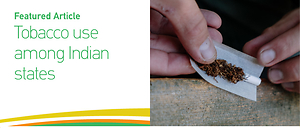Dear Editor,
Tobacco use is associated with accelerated mortality among adults especially in low- and middle-income countries, where the burden of tobacco-related illness and death is heaviest1. More than 1 million adults die each year in India due to tobacco use accounting for 9.5% of overall deaths2. India faces a dual burden of tobacco use in the form of smoking and smokeless tobacco. According to the Global Adult Tobacco Survey (GATS) conducted in 2016–17, the overall prevalence of smoking tobacco use is 10.38% and smokeless tobacco use is 21.38% in India. Of all adults, 28.6% currently consume tobacco either in smoke or smokeless form, including 42.4% of men and 14.2% of women3. The Demographic Health Survey, known as the National Family Health Survey (NFHS) is one of the largest health surveys conducted in India providing disaggregate estimates of several health and demographic indicators. It has been a major source for planning policies and programs for different aspects of health among the Indian population. As NFHS and GATS are nationally representative household surveys using multistage sampling design with an overall response rate of >90%; they produce enough sample size for reliable estimates to be made, at least at state level, for comparison.
The government of India recently released the key findings from Phase 1 of the National Family Health Survey conducted in 2019–20, which also included information regarding current tobacco use among Indian adults in 22 states and union territories4. The results are compared with those of the GATS3 to track the progress in these Indian states (Table 1). Further, the results are stratified in terms of gender and place of residence (rural vs urban) to assess the heterogeneity of tobacco use among Indian adults. The prevalence of tobacco use among men has declined in most states, except Sikkim, Goa, Bihar, Gujarat, Himachal Pradesh, and Mizoram, where an upward trend can be seen. In the case of women, the prevalence has declined in almost all states except Mizoram and Sikkim. Tobacco use in north eastern states remains a challenge5, where prevalence is still quite high. The prevalence of tobacco use in rural areas is higher than in urban areas. The rural–urban divide in the prevalence of tobacco use can be clearly seen in the latest findings. The absolute number of tobacco users in India is still very high due to its huge population, which has a high risk for developing various chronic diseases. The tobacco control programs need more targeted interventions for specific groups in the population. Despite all cessation policies, people are still consuming tobacco in both forms in India. The tobacco users should be strongly encouraged to quit tobacco to eliminate long-term detrimental effects on their health. The decline in tobacco use definitely shows some positive signs for tobacco prevention and cessation programs in India, but it is yet far from achieving the goal of a tobacco-free India.
Table 1
Prevalence (%) of tobacco use among men and women aged ≥15 years across the states of India


